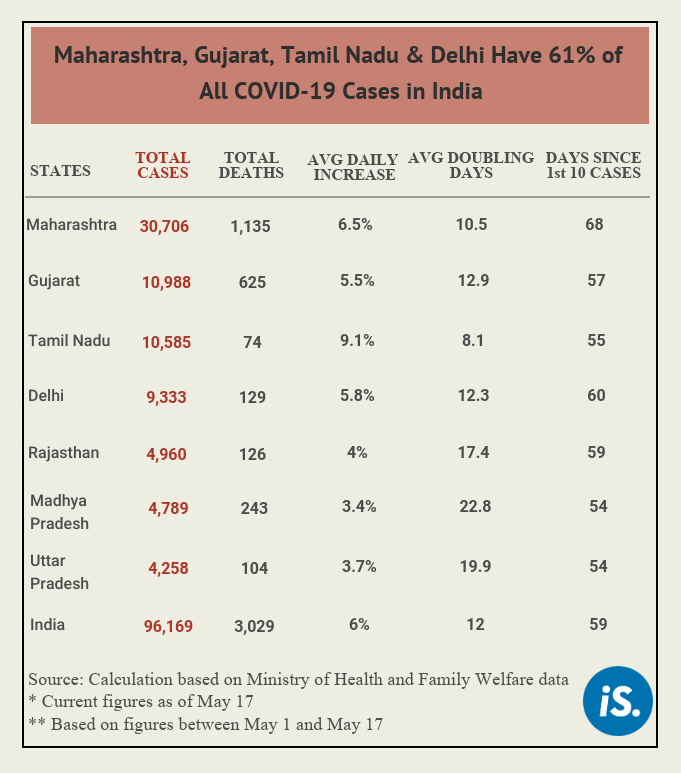Four states report 61% of India’s cases, but doubling time varies from 8 to 13 days
New Delhi: As India extends the lockdown for two more weeks until May 31, with more freedom to states to relax the lockdown for businesses, the country had 96,169 confirmed COVID-19 cases on May 18, an increase of 172% from 35,365 on May 1, 2020, when the lifting of curbs began.
Four states that lead India’s case tally--Tamil Nadu, Maharashtra, Gujarat and Delhi--have reported more than 9,000 cases each, accounting for 61% of all cases in the country, according to an analysis of data from HealthCheck’s Coronavirus Monitor.
Cases grew by 355% to 10,585 in Tamil Nadu, by 192% to 30,706 in Maharashtra, by 165.5% to 9,333 in Delhi and 150% to 10,888 in Gujarat, between May 1 and May 17, data show.
These rates are based on a three-day moving average of confirmed cases to smoothen out day-to-day fluctuations due to differences in day-to-day testing.
These rates of growth are also reflected in the current doubling time for cases. The average doubling time of cases in India was 12 days between May 1 and May 17, compared to 10.5 days in Maharashtra, 12 days in Delhi, 13 days in Gujarat, and eight days in Tamil Nadu. Even slight variations in the doubling time can drastically affect projections of future cases, as IndiaSpend reported on May 13, 2020.
In Uttar Pradesh, Rajasthan and Madhya Pradesh, the next three states with the largest number of confirmed cases, daily case growth averaged 4% over the same period. Cases increased by 92% to 4,960 in Rajasthan, by 87% to 4,258 in Uttar Pradesh, and by 76% to 4,789 in Madhya Pradesh between May 1 and May 17. The doubling time was 17 days in Rajasthan, 20 days in Uttar Pradesh, and 23 days in Madhya Pradesh during the same period.
Kerala, which was the first state in the country with 10 confirmed cases 70 days ago, reported an 18% increase with 90 new cases so far in May 2020.
Reported COVID-19 figures may not reflect the reality. COVID-19 infections may manifest as mild or without symptoms while remaining contagious. Under the Indian Council of Medical Research’s testing strategy, individuals presenting mild or no symptoms are only being tested if they are frontline workers, have a history of international travel in the previous 14 days or have been in direct contact with a confirmed case. It is possible that mildly symptomatic individuals who do not know that they were exposed to the disease are missed out while testing.
India has one of the lowest testing rates in the world, with only 1.5 samples tested per 1,000 people, compared to 32 in the US, 13 in Malaysia, and eight in Iran. Amongst BRICS (Brazil, Russia, India, China, South Africa) countries, Russia has conducted 45 tests per 1,000 people and South Africa, seven. India’s testing rate is more in line with Pakistan’s 1.6 per 1,000, Bangladesh’s 1 per 1,000 and Nepal’s 0.8 per 1,000.

(Bharadwaj, an undergraduate at Yale University, is an intern with IndiaSpend.)


